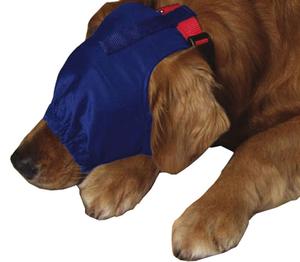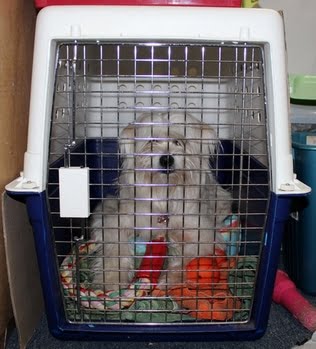Travelling with Pets in Cars (continued)
Treating Travel Fear
Treating car stress can be very tricky if for no other reason that when in the car, your duty is to drive safely.
You can’t do this if you are also trying to make your dog sit, stay and shut up at the same time.
Goodness, it’s hard enough to achieve that with kids in the car, let alone the paranoid pooch! Nevertheless, the following processes should resolve the problem.

1. First Obscure Vision
Firstly, because most of the stimulation for your dog’s misbehaviour is the visual overload it experiences, try obscuring its vision outside the vehicle.
For small to medium-sized dogs, this is most safely achieved by having the dog in a transport cage or crate with semi-solid sides – the type you would commonly use to take your pooch to the vet. Such cages are readily available from pet shops.
With the dog in the cage, it cannot see through the windows.
Transporting your dog in a transport cage is actually part of an effective process called the Denning Principle. You can read the details here (it’s a member’s file but well worth the investment
You an also condition your dog to love the Den when it is at home so that it is more likely to enjoy the car when travelling inside the Den on the back seat.
This also works well for many cats.
For big dogs, try tethering them with a harness as low as possible in the car.

A commercially available device called a Back Seat Buddy can also be useful. This is like a hammock that suspended between the back of the front seats to the seat-belt attachments of the parcel shelf, thus covering the seat and foot-well.
Attach this to the centre of the back seat or to the middle of the back of the station wagon so they cannot get to the windows.
The manufacturers claim dogs are less stressful in the car because they are able to relax securely on top of the hammock.
We are also trialing (with pleasing success) a new device called a Calming Cap which is a strange device that fixes to your dog’s collar and partly obscures vision.
2. Train Your Pet to be Calm
You can also try to modify your dog’s behaviour by progressively desensitising it to car travel.
The goal is to create calm behaviour away from the car.
- Reward your dog for calm behaviour when it is in the stationary car with the doors open…
- and then with the door closed…
- Then try a short trip and…
- Gradually increase the length of the trips as your Pooch learns to remain calm.

For this purpose, you need to develop a command/reward routine.
There are several options but one is to train your dog to lie peacefully on a ‘happy mat’ and combine this with the Circle of Commands.
Try these steps:-
- Place a dog-sized mat in your lounge-room and scent it with your own perfume or deodorant so that the smell of the mat is familiar and friendly. Every time you use the mat, the scent will help to calm the dog.
- Command your dog to ‘GO TO BED’ and then to STAY on the scented mat for ten seconds. If he or she does so, reward it with a food treat and praise it enthusiastically
- Then command COME to remove it from the mat.
Do this circle of three commands (‘GO TO BED – STAY – COME’) fifteen times morning and evening so your pooch learns the new routine.
As your dog responds, increase the time of the STAY from ten to fifteen to twenty seconds and so on.
Once the message has been learnt…
- Move the scented mat to the car
- Place the mat on the back seat and follow the same routine with all the car doors open.
- 1If your pooch retains his or her calm demeanour, then close the doors, repeating the circle of commands many times to reward this calm behaviour
In this manner, you are continually rehearsing the behaviour you want your dog to show when you are driving in the car – and – your dog is enjoying it.
Eventually try a test drive on a quite road or even in a nearby car park that you can walk to, where it is safe to stop and start.
If your pooch starts to get restless, immediately stop the car and command GO TO BED.
Wait for the calm behaviour to return, reward this behaviour, and continue with your therapeutic car trip.
Sure such processes are time consuming! But for many madly manic motorcar mutts this is the only way of getting them to over their travel terror.

3. Pheromones To Calm Travelling Pets
In France, the use of collars soaked in Dog Appeasing Pheromone has proven effective.
However, this form of the Dog Appeasing Pheromone is not available in Australia at this stage.
But we have two alternatives that are available.
- One is to plug the DAP Diffuser into a 12 volt power inverter that you can get from electronic stores or auto shops. That will then power the 240 volt pheromone diffuser.
- The second is to use the DAP spray and spray that onto a towel that you have inside the car, close to where the dog will rest will travelling. A liberal spray of the DAP will last for onie to two hours and can then be repeated. The spray has a strong alcohol perfume when first used to allow about 10 minutes for that to evaporate before driving.
4. Medications for Travel Anxieties
For some dogs, medication is the only practical way of managing the problem.Some dogs require medication for the nausea and some require quick-acting anti-anxiety medications.
For more details, please contact your own veterinarian or my office but be careful about which medication is administered – some medications are not suitable for car travel.

References
Bergero, D. 2004. New insights related to the nutritional management of endurance horses. Proceedings of 2nd European Nutrition and Health Congress, Mar 19-20 2004
